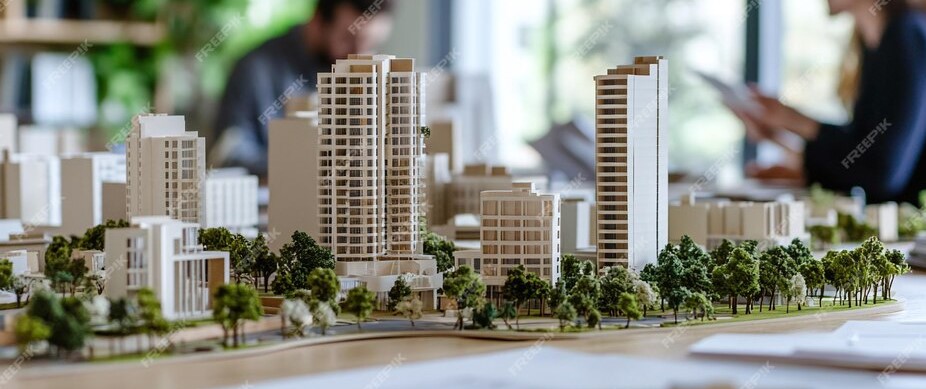
Collaborative Real Estate Development: A Practical Path to Affordable Housing in Ghana
In Ghana, the dream of owning a home remains elusive for many young working individuals, especially in the face of skyrocketing land prices, construction costs, and limited access to affordable housing finance. However, innovative approaches in real estate present exciting alternatives. One such strategy gaining traction is collaborative housing development, where groups of friends come together to share the cost of land acquisition and construction, making homeownership more achievable.
This write-up explores how three friends can jointly purchase a 100x70ft plot of land in a peri-urban area for GHS 150,000, and construct three independent 2-bedroom homes within a shared construction budget of GHS 950,000 over a 3 year timeline. This collaborative model is not only practical but empowering offering a sustainable path for young professionals to step into homeownership.
The Housing Landscape in Ghana: Why This Matters
- Ghana currently faces a housing deficit of over 1.8 million units, with demand growing rapidly due to urbanisation and population growth (Ghana Statistical Service, 2023).
- The average cost of a 2 – 3 bedroom house in urban areas ranges between GHS 450,000 and GHS 800,000, far beyond the affordability levels of most salaried workers.
- Rent prices continue to escalate, with two bedroom units in peri-urban areas now costing GHS 1,200 – 2,000/month, and most landlords requiring 1 – 2 years advance payments.
- A report by the Centre for Affordable Housing Finance in Africa (CAHF) estimates that only 12% – 15% of Ghanaians can access mortgage financing, further limiting homeownership opportunities for young professionals.
Clearly, traditional homeownership models no longer serve the average Ghanaian, making collaborative real estate development a smart and viable alternative.
The Plan: Building Together, Living Independently
1. Land Acquisition – Shared Investment, Greater Value
Instead of each friend purchasing an individual plot, the group can jointly acquire a 100x70ft plot in a peri-urban area (e.g., Oyibi, Amasaman, or Pokuase) for GHS 150,000. This reduces the individual land cost to GHS 50,000 per person, and a legally binding joint ownership agreement ensures each friend’s interest is protected.
Key Benefit: Access to valuable land in a growing area at a reduced individual cost.
2. Cost-Effective Construction – Quality Within Budget
With a total project budget of GHS 950,000, the construction budget for the three homes is GHS 750,000, translating to GHS 250,000 per home. This budget allows for functional 2 bedroom homes, each with essential amenities such as:
- 2 bedrooms
- 1 or 2 bathrooms
- Open living and dining area
- Compact, modern kitchen
- Private entrance
Smart Construction Strategies:
- Utilise cost effective building materials like interlocking bricks or stabilised earth blocks.
- Design simple, efficient layouts that reduce labour and material costs.
- Bulk purchase materials (cement, iron rods, tiles) to access supplier discounts, if any.
- Work with reliable local contractors to ensure timely delivery and reduce cost overruns.
3. Efficient Plot Utilisation – Smart Space, Better Living
Despite the compact size, a 100x70ft plot is adequate for three independent 2 bedroom homes with thoughtful planning.
Possible Layout Options:
- Row Housing: Homes built side-by-side, each occupying roughly 30x70ft.
- Cluster Housing: Homes arranged around a shared courtyard to foster social interaction.
- Vertical Expansion: Two storey structures, with one home per floor. (not very common in Ghana)
Shared Infrastructure Enhancements:
- Borehole and water storage system
- Centralised septic tank or bio-digester
- Perimeter wall with gate for security
- Shared driveway or communal area
4. Phased Project Implementation – Spreading the Cost
To make the investment more manageable, the project is broken into three phases over three years:
- Year 1: Land acquisition, legal agreements, site fencing, and borehole drilling
- Year 2: Construction of home structures, roofing, plumbing, and wiring
- Year 3: Finishing works – plastering, tiling, painting, landscaping, and inspections
Phased execution allows friends to stagger payments, reducing financial pressure while maintaining project momentum.
| Budget Breakdown | ||
| Category | Total (GHS) | Per Person (GHS) |
| Land Purchase (Peri-urban) | 150,000 | 50,000 |
| Construction (3 Homes) | 750,000 | 250,000 |
| Shared Infrastructure | 30,000 | 10,000 |
| Legal & Permit Fees | 20,000 | 6,667 |
| Total Budget | 950,000 | 316,667 |
Why Ghana’s Working-Class Professionals Should Consider This Model
- Affordability Without Compromise – Modern 2-bedroom homes for under GHS 320,000
- Shared Responsibility – Lower cost per person on land, infrastructure, and permits
- Smart Investment – Property ownership in fast-growing peri-urban zones
- Secure Future – Escape from rent stress and rising housing costs
- Community Living – Build lasting bonds with trusted friends while enjoying privacy
A Vision Beyond Housing – A Lifestyle Shift
This collaborative model isn’t just about building houses, it’s about building communities, creating generational wealth, and reshaping how young professionals approach housing in Ghana. It proves that with cooperation, vision, and planning, homeownership can move from a distant dream to a tangible, affordable reality.
“Don’t wait to do it alone. Build together, grow together, live better.”
Let’s redefine what homeownership means. Together, we can build more than homes, we can build futures.
